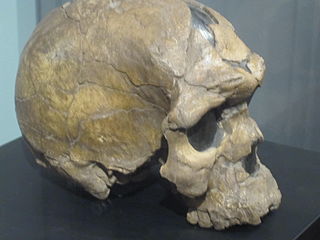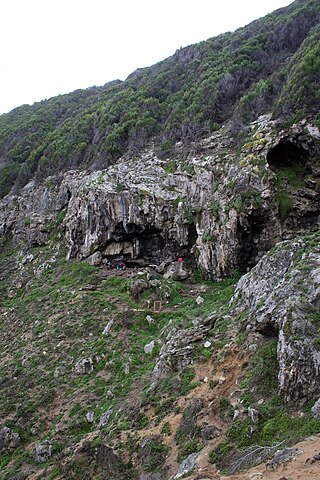Related Research Articles

The Olduvai Gorge or Oldupai Gorge in Tanzania is one of the most important paleoanthropological localities in the world; the many sites exposed by the gorge have proven invaluable in furthering understanding of early human evolution. A steep-sided ravine in the Great Rift Valley that stretches across East Africa, it is about 48 km long, and is located in the eastern Serengeti Plains within the Ngorongoro Conservation Area in the Olbalbal ward located in Ngorongoro District of Arusha Region, about 45 kilometres from Laetoli, another important archaeological locality of early human occupation. The British/Kenyan paleoanthropologist-archeologist team of Mary and Louis Leakey established excavation and research programs at Olduvai Gorge that achieved great advances in human knowledge and are world-renowned. The site is registered as one of the National Historic Sites of Tanzania.

The Oldowan was a widespread stone tool archaeological industry (style) in prehistory. These early tools were simple, usually made with one or a few flakes chipped off with another stone. Oldowan tools were used during the Lower Paleolithic period, 2.9 million years ago up until at least 1.7 million years ago (Ma), by ancient Hominins across much of Africa. This technological industry was followed by the more sophisticated Acheulean industry.

Herto Man refers to human remains discovered in 1997 from the Upper Herto member of the Bouri Formation in the Afar Triangle, Ethiopia. The remains have been dated as between 154,000 and 160,000 years old. The discovery of Herto Man was especially significant at the time, falling within a long gap in the fossil record between 300 and 100 thousand years ago and representing the oldest dated H. sapiens remains then described.

Blombos Cave is an archaeological site located in Blombos Private Nature Reserve, about 300 km east of Cape Town on the Southern Cape coastline, South Africa. The cave contains Middle Stone Age (MSA) deposits currently dated at between c. 100,000 and 70,000 years Before Present (BP), and a Late Stone Age sequence dated at between 2000 and 300 years BP. The cave site was first excavated in 1991 and field work has been conducted there on a regular basis since 1997, and is ongoing.
The following outline is provided as an overview of and topical guide to archaeology:

The Omo Kibish Formation or simply Kibish Formation is a geological formation in the Lower Omo Valley of southwestern Ethiopia. It is named after the nearby Omo River and is subdivided into four members known as Members I-IV. The members are numbered in the order in which they were deposited and date between 196 ka ~ 13-4 ka. Omo Kibish and the neighboring formations have produced a rich paleoanthropological record with many hominin and stone tool finds. The Kibish formation, in particular, is most notable for Richard Leakey's work there in 1967 during which he and his team found one of the oldest remains of anatomically modern Homo sapiens. Known as Omo Kibish 1, the fossil was dated to 196 ± 5 ka old and is among two other Omo remains that were found in Member I. The Omo fossils were more recently re-dated to approximately 233 ± 22 ka old. In the early 2000s a research boom enriched the knowledge base about the Kibish Formation. Study of the faunal remains and stone tools provided insight into the archeological associations of Homo sapiens and thereby their behaviors and the complex environmental contexts in which they lived and evolved.
Mumba Cave, located near the highly alkaline Lake Eyasi in Karatu District, Arusha Region, Tanzania. The cave is a rich archaeological site noted for deposits spanning the transition between the Middle Stone Age and Late Stone Age in Eastern Africa. The transitional nature of the site has been attributed to the large presence of its large assemblage of ostrich eggshell beads and more importantly, the abundance of microlith technology. Because these type artifacts were found within the site it has led archaeologists to believe that the site could provide insight into the origins of modern human behavior. The cave was originally tested by Ludwig Kohl-Larsen and his wife Margit in their 1934 to 1936 expedition. They found abundant artifacts, rock art, and burials. However, only brief descriptions of these findings were ever published. That being said, work of the Kohl-Larsens has been seen as very accomplished due to their attention to detail, especially when one considers that neither was versed in proper archaeological techniques at the time of excavation. The site has since been reexamined in an effort to reanalyze and complement the work that has already been done, but the ramifications of improper excavations of the past are still being felt today, specifically in the unreliable collection of C-14 data and confusing stratigraphy.
Enkapune Ya Muto, also known as Twilight Cave, is a site spanning the late Middle Stone Age to the Late Stone Age on the Mau Escarpment of Kenya. This time span has allowed for further study of the transition from the Middle Stone Age to the Late Stone Age. In particular, the changes in lithic and pottery industries can be tracked over these time periods as well as transitions from a hunter-gatherer lifestyle to a herding lifestyle. Beads made of perforated ostrich egg shells found at the site have been dated to 40,000 years ago. The beads found at the site represent the early human use of personal ornaments. Inferences pertaining to climate and environment changes during the pre-Holocene and Holocene period have been made based from faunal remains based in this site.

The Bouri Formation is a sequence of sedimentary deposits that is the source of australopithecine and Homo fossils, artifacts, and bones of large mammals with cut marks from butchery with tools by early hominins. It is located in the Middle Awash Valley, in Ethiopia, East Africa, and is a part of the Afar Depression that has provided rich human fossil sites such as Gona and Hadar.

The Florisbad Skull is an important human fossil of the early Middle Stone Age, representing either late Homo heidelbergensis or early Homo sapiens. It was discovered in 1932 by T. F. Dreyer at the Florisbad site, Free State Province, South Africa.

Border Cave is an archaeological site located in the western Lebombo Mountains in Kwazulu-Natal. The rock shelter has one of the longest archaeological records in southern Africa, which spans from the Middle Stone Age to the Iron Age.

Scladina, or Sclayn Cave, is an archaeological site located in Wallonia in the town of Sclayn, in the Andenne hills in Belgium, where excavations since 1978 have provided the material for an exhaustive collection of over thirteen thousand Mousterian stone artifacts and the fossilized remains of an especially ancient Neanderthal, called the Scladina child were discovered in 1993.
Elands Bay Cave is located near the mouth of the Verlorenvlei estuary on the Atlantic coast of South Africa's Western Cape Province. The climate has continuously become drier since the habitation of hunter-gatherers in the Later Pleistocene. The archaeological remains recovered from previous excavations at Elands Bay Cave have been studied to help answer questions regarding the relationship of people and their landscape, the role of climate change that could have determined or influenced subsistence changes, and the impact of pastoralism and agriculture on hunter-gatherer communities.
The Obi-Rakhmat Grotto is a Middle Paleolithic prehistoric site that yielded Neanderthal fossils. It is a shallow karst cave near the junction of the Chatkal and Pskem Rivers at the southwestern end of the Talassky Alatau Range in the Tien Shan Mountains, 100 km (62 mi) northeast of Tashkent, Uzbekistan.
Matupi Cave is a cave in the Mount Hoyo massif of the Ituri Rainforest, Democratic Republic of the Congo, where archaeologists have found evidence for Late Stone Age human occupation spanning over 40,000 years. The cave has some of the earliest evidence in the world for microlithic tool technologies.

The region of Southeast Asia is considered a possible place for the evidence of archaic human remains that could be found due to the pathway between Australia and mainland Southeast Asia, where the migration of multiple early humans has occurred out of Africa. One of many pieces of evidence is of the early human found in central Java of Indonesia in the late 19th century by Eugene Dubois, and later in 1937 at Sangiran site by G.H.R. van Koenigswald. These skull and fossil materials are Homo erectus, named Pithecanthropus erectus by Dubois and Meganthropus palaeojavanicus by van Koenigswald. They were dated to c. 1.88 and 1.66 Ma, as suggested by Swisher et al. by analysis of volcanic rocks.

Krapina Neanderthal site, also known as Hušnjakovo Hill is a Paleolithic archaeological site located near Krapina, Croatia.

The Cave of Aroeira is an archaeological and paleoanthropological site in the Portuguese Estremadura Limestone Massif. The cave is located in the village of Almonda, in the civil parish of Zibreira, in the municipality of Torres Novas in the district of Santarém. The cave contained stones from the Paleolithic Acheulean culture, and the skull of Homo heidelbergensis, circa 400,000 years old. The discovery of Aroeira 3 was announced in spring 2017 - the earliest human trace in Portugal.
Porc-Epic Cave is an archaeological site located in Dire Dawa,Oromia, Ethiopia. Dated back to the Middle Stone Age, the site contains extensive evidence of microlithic tools, bone, and faunal remains. The lithic assemblage reveals that inhabitants at the time were well-organized with their environment. There is also rock art and strong evidence for ochre processing. The site was first discovered in 1920 by H. De Monfreid and P. Teilhard De Chardin. H. Breuil and P. Wernert performed the first excavation in 1933, followed from 1974 to 1976 by J. Desmond Clark and K.D. Williamson. Succeeding this was an excavation in 1998. Porc-Epic Cave provides insight into the behavior and technical capability of modern humans in eastern Africa during the Middle Stone Age.

The Mlambalasi Rock Shelter is a historic site located in Iringa District of Iringa Region in southern Tanzania, 50 km away from Iringa City. Excavations in 2006 and 2010 by the Iringa Region Archaeological Project uncovered artifactual deposits from the Later Stone Age (LSA), the Iron Age, and the historic periods, as well as external artifacts from the Middle Stone Age (MSA). Direct dating on Achatina shell and ostrich eggshell beads indicates that the oldest human burials at Mlambalasi are from the terminal Pleistocene. Mlambalasi is characterized by interment in the LSA and Iron Age periods, as well as by cycles of use and abandonment.
References
- ↑ Kuman, Kathleen; Clarke, R. J. (April 1986). "Florisbad-New Investigations at a Middle Stone Age Hominid Site in South Africa" (PDF). Geoarchaeology. 1 (2). doi:10.1002/gea.3340010201 . Retrieved 26 December 2021.
- ↑ Toffolo, Michael B.; Brink, James S.; van Huyssteen, Cornie; Berna, Francesco (July 2017). "A microstratigraphic reevaluation of the Florisbad spring site, Free State Province, South Africa: Formation processes and paleoenvironment: Toffolo et al". Geoarchaeology. 32 (4): 456–478. doi:10.1002/gea.21616.
- ↑ Douglas, R.M. (May 2006). "Formation of the Florisbad spring and fossil site – an alternative hypothesis". Journal of Archaeological Science. 33 (5): 696–706. doi:10.1016/j.jas.2005.10.005.
- 1 2 3 4 5 6 7 8 9 10 11 12 13 14 15 16 Kuman, Kathleen; Clarke, R. J. (April 1986). "Florisbad—New investigations at a middle stone age Hominid Site in South Africa". Geoarchaeology. 1 (2): 103–125. doi:10.1002/gea.3340010201.
- 1 2 Bamford, Marion K; Henderson, Zoë L (June 2003). "A reassessment of the wooden fragment from Florisbad, South Africa". Journal of Archaeological Science. 30 (6): 637–650. doi:10.1016/S0305-4403(02)00245-5.